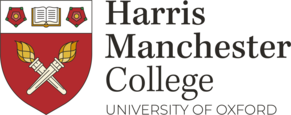Margaret Sutton Sharpe
Margaret Sutton Sharpe
The name Margaret Sutton Sharpe appears in a brief paragraph in various regional newspapers in January 1924. Several papers try to boost the story with lurid headlines - ‘Policewomen’s Slum Work’ and ‘Lady Minister as Police Woman’ – but the facts remain that Miss Margaret Sutton Sharpe had been appointed as a policewomen in Oxford in January 1924, having studied at Manchester College, Oxford for two years, following a career in social work. Sharpe wasn’t the first policewoman employed by the Oxford force, that was Grace Costin in 1917 (who was also a social worker), but it was a rare enough event for the story to feature not only in the Oxford press, but also to be carried by papers as far away as Derby, Newcastle and Liverpool.
Sharpe grew up in Hampstead, a wealthy suburb of London, and was the daughter of Sutton Sharpe and Caroline Toulmin Sharpe. The Sharpe family were a long established Unitarian family with various branches across London. Her branch of the family were particularly known for their artistic prowess, with Sharpe’s mother and Aunt (Helen Allingham) being very successful watercolour artists. Her great Aunt, Laura Herford, was also the first women to be admitted to the Royal Academy (1860).
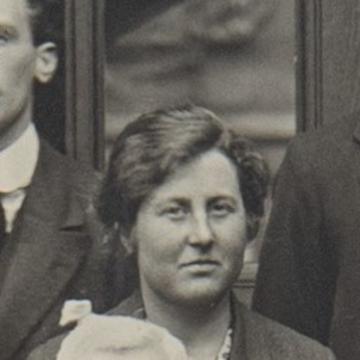
Margaret Sutton Sharpe in a College Photograph 1922
We know a little bit about Sharpe’s life before she came to Oxford as we have her letter of introduction to College staff. She was 27 when she arrived at Manchester College and she explains that ‘she had the usual private girls school education, but went in for no public examinations owing to home circumstances’. After school she became a student at the Women’s University Settlement, London for a year and a half, where she attended lectures at the London School of Economics on social subjects. After this she starts to work both on a voluntary and paid basis in social work. In her letter, she mentions she has volunteered at the Women’s University Settlement (an initiative that aimed to promote the education and living standards of poor women and children in London by encouraging better off women to live in and help work for the community for free). In addition to her work at the Settlement, Sharpe worked as a secretary at the newly established Invalid Kitchen in Islington. She also mentions that for a year she worked on a market garden in Evesham ‘not amongst a squad of women but as one women amongst the men, who were a mixture of the ordinary agricultural labourers and young Quakers’. This is likely to have been during the First World War. Following Evesham she went to work on the land and took up a post as a superintendent of a small agricultural training centre before it closed in 1919. She mentions that she been working at the Unitarian Stamford Street Chapel in Southwark on Sundays and during the week, which will have been key information for the College in considering her application for Ministry.
We have some mention of Sharpe’s time in College, including a Principal’s report on students’ progress from 1923. In the report Sharpe looks to have improved on the previous year’s performance – ‘In her Old Testament Essay on “Job” its place in the evolution of the problem of suffering represents a considerable advance on last year’s interest in and knowledge of O.T. Studies’ – although there were still some criticisms of her work – ‘her style is unformed and she has difficulty in expressing herself clearly.’
She does appear in the records for the Debating Society where she seems to have been an active member contributing to debates covering such questions as the Irish Question, Prohibition and Social Welfare, and the Illusion of Progress. One rather intriguing debate which she took part in was ‘That the Witch persecutions in Europe were due to the desire on the part of male ministers of religion to suppress ministerial gifts on the part of women’. (This particular debate was lost by 6 votes.)
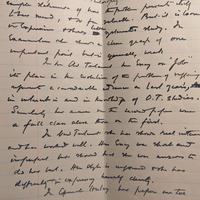
Principal's report on Sharpe's academic work (above)
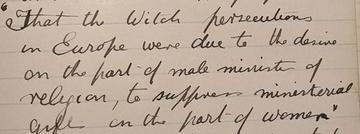
A topic proposed at the 304th Debating Society's meeting (above)
Sharpe was one many women who attended College during the 20s. The 1923 College photograph show nearly an equal number of male and female students, and the Annual Report for that year notes ‘ A new feature in the College life has been the presence of a considerable number of women students for the ministry. The present proportions are eight men and seven women. Many questions connected both with the work and social life of the students have naturally arisen. No serious difficulties have occurred, and minor difficulties overcome. The women have shown a capacity to grapple with the studies prescribed for them fully equal to that of the men, and their industry has been highly satisfactory.’
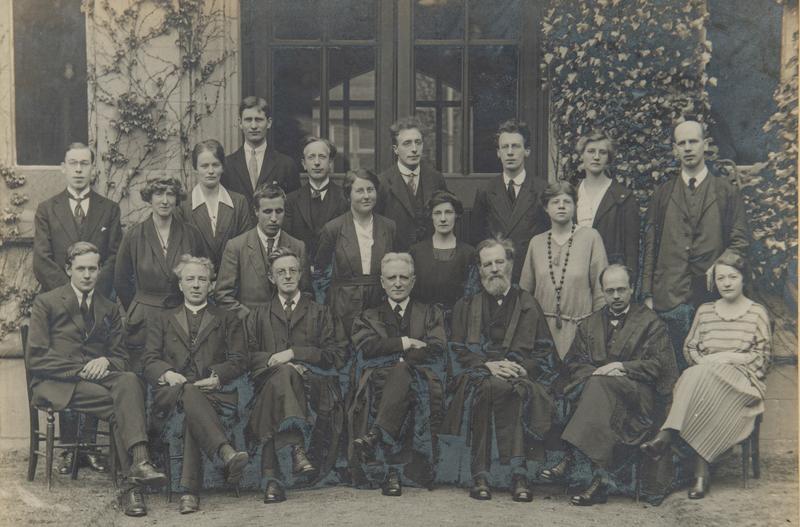
Sharpe didn’t finish her course at Manchester College, leaving after two years and we have nothing to indicate why she left. All we know is that the year after she finished here she was appointed to her post in the Oxford Constabulary where she remained for 18 months before resigning. On her resignation she was awarded a gold watch and handbag from her colleagues. It was reported that she was leaving to become a Minister at Taunton.
Sharpe was one of several women from her year to blaze a trail in their field. Ada Tonkin, who completed her studies at Manchester College like Sharpe in 1922, went off to Canada to become a minister although soon found herself appointed as Director of the Women’s Protective Division of the Vancouver Police Force (1929). Joyce Daplyn overlapped briefly with Sharpe in 1923. Daplyn went on to organise an influential conference called ‘The Opening of the Ministry of Religion to Women’, attracting women from various religious traditions, before very sadly dying young in 1931.
Unfortunately we don't know what happened to Sharpe once she left Oxford but hope she continued to be a pioneer in her field.
Above - College photograph from 1923. Margaret Sutton Sharpe is standing in the centre of the photograph. Ada Tonkin is seated at the far right and Joyce Daplyn is standing at the right in the middle row. The other women shown are Constance Harris, Leila Lasley Thompson, Grace Mewhort and Marguerite Pollard.
